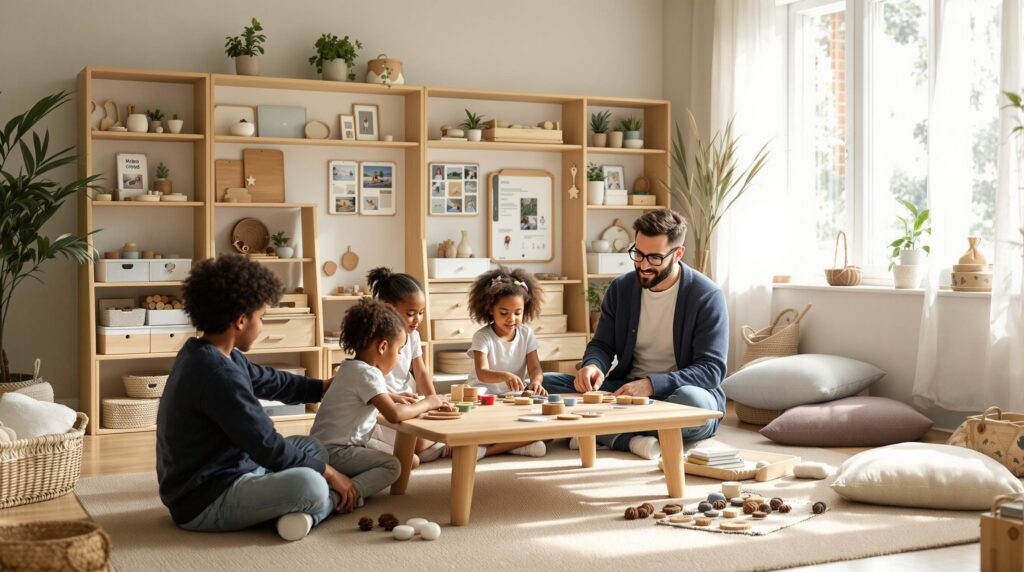Table of Contents
ToggleThe Rise of Micro-Schools: Are Small Classrooms the Future?
Understanding Micro-Schools: A New Trend in Early Education
Micro-schools represent an innovative approach to education that’s gaining significant traction among parents seeking alternatives to traditional schooling options. These small, independent educational institutions focus on personalized learning experiences and maintain intentionally small class sizes—particularly for toddlers aged 2-4 years. Unlike conventional preschools that might accommodate 15-20 children per classroom, micro-schools typically limit enrollment to 5-10 students per teacher, creating an intimate learning environment.
This educational model has experienced remarkable growth in recent years. Data shows that the number of micro-schools across the United States has increased by approximately 30% since 2018, with parental satisfaction rates exceeding 85% according to surveys conducted by the National Association for the Education of Young Children. Parents consistently report higher levels of engagement and more pronounced developmental progress in their children compared to those attending larger, more traditional early education settings.
The rise of micro-schools isn’t merely coincidental—it responds directly to parents’ increasing desire for educational environments that respect each child’s individuality while fostering strong foundational skills. These schools often combine elements from various educational philosophies, creating hybrid approaches that can be customized based on each child’s specific needs, interests, and developmental trajectory.
What distinguishes micro-schools from traditional daycare centers or preschools is their deliberate focus on learning outcomes without sacrificing the nurturing environment essential for young children. They represent a middle ground between structured educational institutions and the warmth of home-based care—a balance many parents find particularly appealing for their youngest learners.

The Power of Small Classrooms in Early Childhood Development
The impact of classroom size on educational outcomes isn’t just anecdotal—it’s backed by substantial research. The NICHD Study of Early Child Care and Youth Development found that children in smaller groups received significantly more verbal stimulation, responsive care, and positive interactions with teachers. These advantages translate into concrete developmental benefits that can last far beyond the early years.
In smaller educational settings, teachers can genuinely observe each child’s learning style, temperament, and developmental readiness. This granular awareness allows educators to tailor activities and interactions in ways impossible in larger groups. For example, when teaching early literacy concepts, a teacher in a micro-school can notice that one child learns better through songs while another benefits from tactile letter tracing, adjusting their approach accordingly for each student.
The academic advantages of small class sizes are profound. Studies documented by Class Size Matters reveal that children in smaller early education settings demonstrate accelerated language acquisition, stronger pre-literacy skills, and more advanced mathematical thinking compared to peers in larger classrooms. The cognitive benefits extend to enhanced problem-solving abilities and more sophisticated critical thinking skills—crucial foundations for later academic success.
Beyond academics, the social-emotional benefits are equally significant. In micro-schools, children develop deeper connections with both peers and teachers. The intimacy of these environments allows for more authentic relationship-building and creates space for learning crucial social skills like turn-taking, conflict resolution, and empathy. Children who struggle with transitions or emotional regulation receive immediate support rather than becoming lost in the shuffle of a larger group.
Perhaps most importantly, children in smaller classrooms generally experience less stress and anxiety. The predictable relationships and individualized attention create psychological safety that’s fundamentally important for young learners. This emotional security becomes the foundation upon which all other learning can effectively build.
Tailoring Education to Developmental Needs
Understanding child development theories isn’t just academic exercise—it’s essential for creating truly effective early education environments. Micro-schools excel at applying these theoretical frameworks to practical, daily interactions with young children.
Piaget’s Cognitive Development Theory in Practice
Jean Piaget’s cognitive development theory identifies distinct stages children move through as they construct understanding of their world. For toddlers and preschoolers in micro-schools, this primarily involves the preoperational stage (ages 2-7), characterized by symbolic thinking, egocentrism, and magical thinking.
Micro-schools can leverage this developmental understanding by creating environments rich with opportunities for symbolic play. For instance, a classroom might include a dramatic play area where children can engage in pretend scenarios, gradually developing their ability to use symbols and language to represent real-world objects and situations. Teachers in these intimate settings can observe exactly where each child stands developmentally and provide tailored experiences that gently stretch their cognitive abilities without causing frustration.
Consider how a micro-school teacher might respond to a 3-year-old’s egocentric perspective (difficulty seeing situations from others’ viewpoints). In a class of eight children rather than twenty, the teacher can facilitate focused small-group activities specifically designed to gradually develop perspective-taking skills through storytelling, puppetry, and guided discussions—interventions that would be challenging to implement effectively in larger settings.
Freud’s Psychosexual Theory and Emotional Development
While more controversial in modern psychology, aspects of Freud’s psychosexual development theory still inform understanding of young children’s emotional lives. Young children in micro-schools (ages 2-4) typically align with what Freud described as the anal and phallic stages, where issues of autonomy, control, and gender identity become important.
Micro-schools can create environments that respect children’s growing need for independence while providing appropriate boundaries. For example, classroom routines might include significant opportunities for choice-making and self-direction within a predictable structure. This balance helps children develop healthy autonomy without experiencing anxiety from too much freedom or frustration from excessive control.
The small setting allows teachers to respond sensitively to each child’s emotional needs. If one child is struggling with separation anxiety while another needs support with impulse control, both can receive individualized attention simultaneously—something virtually impossible in conventional preschool ratios.
Vygotsky’s Zone of Proximal Development
Lev Vygotsky’s concept of the “zone of proximal development”—the gap between what a child can do independently and what they can accomplish with skilled assistance—finds its ideal expression in micro-school settings. With fewer children competing for attention, teachers can precisely identify each child’s developmental edge and provide exactly the right amount of scaffolding needed for growth.
In practice, this might look like a teacher noticing that a 4-year-old is ready to advance from simple pattern recognition to creating patterns independently. The teacher can sit with the child, providing decreasing levels of support as the child gains confidence—an intervention that requires the focused attention possible only in small-group settings.
By understanding and honoring these developmental stages, micro-schools can better match learning styles and create educational experiences that align with each child’s biological and psychological readiness—ultimately leading to more harmonious development.
Quality Care and Education: The Micro-School Advantage
The quality of early care and education profoundly influences children’s long-term outcomes. The NICHD Study of Early Child Care and Youth Development conclusively demonstrates that high-quality early experiences correlate with better academic performance, social competence, and emotional regulation throughout childhood and adolescence. Micro-schools offer several structural advantages that facilitate this quality care.
Expert Teachers with Focused Attention
Micro-schools typically prioritize hiring highly qualified educators, often with specialized training in early childhood development. These teachers can implement their expertise more effectively in small groups, where their attention isn’t constantly divided among many children with competing needs.
For example, a trained Montessori educator in a micro-school can truly follow the child, observing subtle cues about readiness for new materials or concepts. This teacher might notice that a particularly quiet 3-year-old shows emerging interest in letter sounds and can immediately provide appropriate materials and guidance—catching a window of receptivity that might be missed in a larger classroom.
According to the National Association for the Education of Young Children, the quality of teacher-child interactions represents the single most important predictor of positive outcomes in early education settings. Micro-schools maximize these interactions through their structural design.
Thoughtful Curriculum Implementation
While many early education settings adopt specific curricula, micro-schools can implement these approaches with greater fidelity due to their small size. Whether following Reggio Emilia, Waldorf, Montessori or other educational methods, the intimate environment allows for authentic application rather than diluted approximations.
A project-based investigation in a micro-school, for instance, can genuinely follow children’s interests because teachers have the flexibility to adapt quickly. If children show fascination with shadows after outdoor play, the teacher can immediately pivot to explore this interest through books, art materials, and scientific exploration—following the organic flow of curiosity rather than adhering rigidly to predetermined lesson plans.
This responsiveness creates learning experiences that aren’t just developmentally appropriate but genuinely engaging for young children, fostering intrinsic motivation and positive attitudes toward learning.
Physical Environments That Support Development
Micro-schools often occupy smaller, more intimate spaces that can be meticulously designed to support young children’s developmental needs. Rather than institutional environments with generic furnishings, these spaces typically feature thoughtful design elements scaled appropriately for young bodies and minds.
The physical space might include cozy reading nooks, sensory exploration stations, and natural materials that invite open-ended play. With fewer children sharing these resources, each child has greater access to quality materials without excessive waiting or competition—a significant advantage for young children still developing patience and sharing skills.
The combination of expert teachers, carefully implemented curricula, and thoughtfully designed environments creates an educational ecosystem where young children can truly thrive, building the cognitive, social, and emotional foundations that will support lifelong learning.
Fostering Parental Involvement and Satisfaction
Parental involvement stands as a crucial factor in children’s educational success. Research published by the National Center for Education Statistics confirms that children whose parents actively participate in their education demonstrate higher academic achievement, better attendance, and more positive attitudes toward learning. Micro-schools excel at creating structures that facilitate meaningful parental engagement.
Communication Bridges Between Home and School
The intimate nature of micro-schools enables richer, more personalized communication between parents and teachers. Rather than generic newsletters or brief annual conferences, parents typically receive detailed insights about their child’s specific experiences, challenges, and accomplishments.
These communication channels often include daily digital updates with photos documenting learning activities, weekly personalized progress notes, and frequent face-to-face conversations during pickup and drop-off times. Parents gain authentic visibility into their child’s educational experience, creating continuity between home and school environments.
For example, a parent might learn that their child spent twenty focused minutes building an intricate block structure, demonstrating growing spatial awareness and planning skills. With this specific information, parents can extend the learning at home through related activities or conversations, reinforcing concepts introduced at school.
Meaningful Participation Opportunities
Micro-schools typically offer diverse ways for parents to participate meaningfully in the educational community. Beyond traditional volunteer roles, parents might share special skills or cultural traditions, participate in community service projects alongside children, or contribute to curriculum planning based on their expertise.
This collaborative approach respects parents as their child’s first and most important teachers while acknowledging the specialized knowledge that professional educators bring. The result is a genuine educational partnership rather than the more distanced relationship common in larger institutions.
Parents report especially high satisfaction with micro-schools’ responsiveness to their concerns and questions. When issues arise—whether related to developmental challenges, behavioral concerns, or educational approaches—the smaller setting allows for prompt, personalized responses rather than bureaucratic delays or standardized solutions.
Community Building and Social Networks
Perhaps underappreciated is how micro-schools foster community among families. With a smaller parent population, these schools often create tight-knit social networks that provide emotional support, practical assistance, and friendship beyond the educational setting.
These connections benefit not only parents but children as well, who experience consistency in expectations and values across different contexts. The social capital developed through these relationships creates resources families can draw upon throughout their parenting journey.
The high parental satisfaction reported in micro-school settings stems from this combination of personalized communication, meaningful involvement opportunities, and community connection—factors that support both children’s development and parents’ confidence in their educational choices.
Challenges and Considerations for Micro-Schools
Despite their considerable advantages, micro-schools face significant challenges that influence their accessibility and sustainability. Understanding these limitations helps parents make informed decisions while encouraging stakeholders to develop creative solutions.
Financial Accessibility Concerns
The economic reality of micro-schools presents perhaps their most significant drawback. The favorable teacher-to-student ratios that create their distinctive benefits also generate higher per-student costs. Without the economies of scale enjoyed by larger institutions, micro-schools typically charge tuition rates that place them out of reach for many families.
This financial barrier creates equity concerns, potentially limiting access to this educational model to more affluent families. Some micro-schools address this challenge through sliding-scale tuition, scholarship programs, or creative funding structures involving community partnerships or sponsorships.
For example, a micro-school might partner with a local business that subsidizes spots for employees’ children or children from the surrounding community. Others explore cooperative models where parents contribute time or skills to reduce operational costs, thereby lowering tuition requirements.
Scalability and Capacity Limitations
By definition, micro-schools serve small populations. This intentional limitation creates a capacity problem as demand increases. Popular micro-schools often develop lengthy waitlists, leaving many interested families without access.
The challenge extends beyond individual schools to the broader question of how this educational model might be scaled to serve more children without sacrificing the very qualities that make it effective. Some organizations have developed networks of micro-schools that maintain small classroom sizes but share administrative resources, curriculum development, and teacher training across multiple sites.
This network approach maintains the intimate classroom experience while creating more sustainable operational structures—potentially making the model available to more families.
Transition Considerations
Parents sometimes worry about how children will adjust when transitioning from the nurturing micro-school environment to larger, more traditional settings for elementary education. The stark contrast between educational approaches and class sizes might create adjustment challenges for some children.
Progressive micro-schools address this concern by intentionally preparing children for future educational contexts. They might gradually increase independence expectations for older preschoolers, introduce more structured learning periods as kindergarten approaches, or arrange visits to elementary classrooms to familiarize children with different educational settings.
Some micro-schools have expanded to include elementary grades, allowing families to continue with this educational approach beyond early childhood. Others have created partnerships with charter schools or private elementary programs that share similar philosophical approaches, creating more seamless educational pathways.
The Future of Early Education: Micro-Schools as a Promising Solution
As we look toward the educational landscape of the future, micro-schools offer compelling possibilities for transforming early childhood education. Their continued growth suggests they represent more than a passing trend—they respond to fundamental needs that larger institutions often struggle to address.
Blending Traditional and Progressive Approaches
The flexibility inherent in micro-schools allows them to combine the best elements of various educational traditions. Many incorporate rigorous academic foundations alongside play-based learning, project-based inquiry, and social-emotional development—creating balanced approaches that prepare children for future academic challenges while honoring childhood’s unique developmental needs.
This hybrid approach appeals to parents who value academic preparation but resist overly structured environments for young children. The small setting enables this balance, with teachers adjusting the mixture of approaches based on individual children’s needs rather than applying one-size-fits-all methodologies.
Technology Integration with Human Connection
Forward-thinking micro-schools thoughtfully integrate technology while preserving essential human connections. They might use digital tools for documentation, communication with families, or specific learning applications while maintaining plenty of hands-on, three-dimensional experiences and face-to-face interactions.
This balanced technology approach prepares children for the digital world they’ll inherit without sacrificing the tactile exploration and personal connection crucial for healthy development. The small environment ensures technology serves as a tool rather than a substitute for human teaching.
Influencing Broader Educational Reform
Perhaps most promising is how micro-schools might influence larger educational systems. As these small schools demonstrate the power of personalized learning, intimate community, and developmental responsiveness, they create working models that larger institutions can learn from and potentially adapt.
We’re already seeing this influence in some public school systems that have begun experimenting with self-directed learning and school-within-a-school models that create smaller learning communities within larger buildings. These adaptations suggest micro-schools’ core principles might eventually benefit children beyond those directly enrolled in alternative settings.
While micro-schools won’t replace traditional early education entirely, they represent a significant innovation that responds to contemporary families’ needs and concerns. Their emphasis on personalized attention, developmental appropriateness, and community connection addresses fundamental human needs that transcend educational trends.
For parents considering early education options, micro-schools offer a compelling alternative worth exploring—one that honors the unique potential of each young child while creating the conditions for authentic learning and growth. As these schools continue evolving and addressing accessibility challenges, they may indeed represent an important piece of education’s future.
Sources:
Major Theories of Child Development: Frameworks for Learning
The NICHD Study of Early Child Care and Youth Development
Early Childhood Education and Care
High-Quality Early Learning Settings Depend on a High-Quality Workforce
The Importance of Early Childhood Education
Early Childhood Development: A Review of the Literature
Small Class Size and Student Achievement
Parental Involvement in Education
Early Childhood Education: A Guide for Policymakers
The Benefits of Small Schools
Early Learning and Developmental Guidelines
The Role of Early Childhood Education in Shaping the Future
Early Childhood Education: A Critical Component of Education Reform
Small Schools and Student Achievement
Early Childhood Development and Learning
The Importance of Parental Involvement in Early Childhood Education
Early Childhood Education: A Review of the Literature
Small Class Sizes and Early Childhood Education
Early Childhood Education and Care: A Guide for Practitioners












